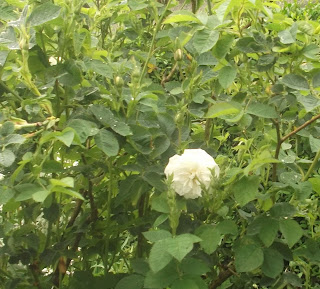On Sunday, I saw my first of these ladys smocks (also known as cuckoo flowers) growing in the forecourt of the police station. They are much earlier here in the west, than I was expecting, but it seems to me that the celandines, which have appeared en masse this week, are rather later. Along the footpath and in the park, the green things, which seemed to have stopped and started during March, have suddenly stirred into action. Ferns are unfolding, sheets of acid green petty spurge (also known as milkweed), dogs mercury – which indicates ancient woodland – and bluebell leaves are showing in the wilder bits of the park, and shepherd’s purse, ground ivy and whitlow grass are along the pavements. I never expected so much plantlife in this built up suburb, but it seems even more abundant here than back in Stirling.
The birds are busier too. We have several goldfinches, siskins, blue tits and chaffinches as regular visitors to the bird feeder. Though the sparrows seem to have dispersed a little, the blackbirds are back and the starlings are still here in their bronzed summer feathers. The common gulls have been joined by lesser black-backed gulls, and I can hear woodpeckers drumming in the trees along the footpath whenever I go out into the garden. All the smaller trees are wearing more green – hawthorn, birch, bramble, poplar and hazel, and the pink cherry trees the builders scattered around the estate have fat buds just ready to open.
In the garden, I have seeds germinating in the cold frame, leaves on the dwarf willow and new shoots of lily of the valley and martagon lilies. The culinary herbs are settling into their new patch, and the first flowers have appeared on the rosemary. The beds at the back are looking a little bare, as I’m moving some plants to the front, and the new herbs to replace them won’t be ready for a while, but there are tulips I didn’t expect coming out all pink and scarlet, and plenty of purple blossom developing on the lilac.
Settling into this new space is like folk dancing – advance and retire, hands across the set, turn and progress. You think you discover something, you realise you got it wrong, then maybe, after all …. This garden does have more light and air than our previous garden, as I expected, and the soil is as heavy, but it isn’t acid, and barren. It is rich, and though full of stones, it’s also full of worms and grubs and ladybirds, and bumble bees have come out in hundreds now the weather is warm. In winter the back of the house was in shadow all morning and the sun rose straight into my study window, but now the first light shines into the windows to the right, and by ten the sun is so high over the roofs that most of the back, as well as all of the front, is in the light. The soil is not as wet as I had imagined on the south side – in fact it seems to have dried out a lot in the last coouple of weeks – but against the north and west fences, it’s still very wet. I think there may be an underground watercourse running down into the burn behind the house, and I’m planning to move all the wet-loving herbs – the marsh mallows, the flag irises and the meadowsweet there.
It seems appropriate too, that there are finally new poems to think about, and new kinds of writing to experiment with. I haven’t done many reviews lately, because I still have fourteen boxes of books waiting for shelves, but I am working on an essay about geopoetics as a commentary on a discussion project I am working on with Pentland poet Helen Boden, whose debut collection A Landscape to Figure In was published by Red Squirrel Press last October. Look out for this in my next newsletter, which I hope to send out next month sometime.









